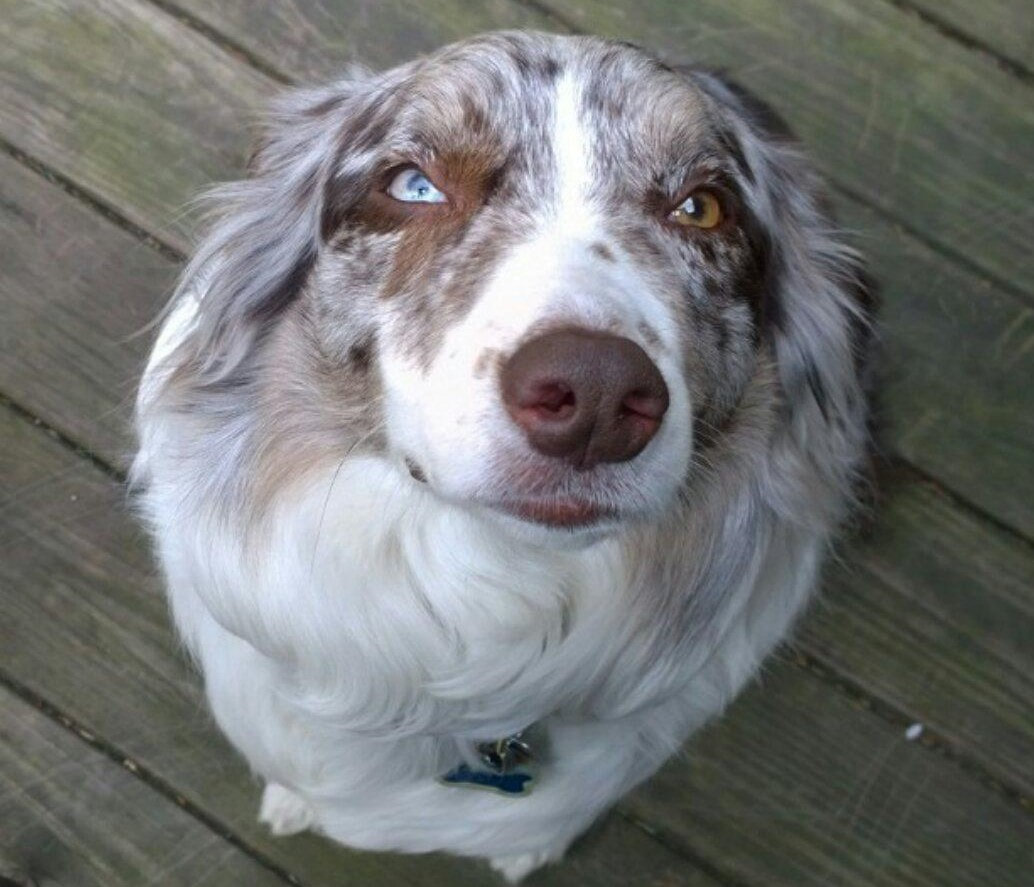|
I called her Pretty Girl whenever she sat by my side. She must have known I was smitten, because she let me pet her and talk to her even if her immediate family members were right there. She was a Blue Merle Australian Shepherd, a highly desirable breed, tooled to chase sheep up a steep incline, sorting out dawdlers. She could muster her speed and power when let loose in safe terrain but she was gentle and domesticated in Dave and Joelle’s house, near us. She had beautiful color and soft hair and a sleek face. She could have been a model.  Max Scherzer Max Scherzer She was named Blue, for her right eye, alongside her darker left eye. Exactly -- just like Max Scherzer, the traveling pitching star, currently with the Mets. When I see Scherzer blowing hitters away, I think of Blue. (The web says 5 per cent of Blue Merle Australian Shepherds have one blue eye, a genetic variant.) (The web also says a small percentage of humans has one blue eye, from a common ancestor 6-10,000 years ago.) I never saw Blue show a temper, even when Isabel’s cat or Greta’s cat sauntered by. Blue tolerated the felines, shared food space and floor space. She was beautiful; she had nothing to prove. I am not a dog person (and my wife has major dog allergies), but I did love our highly neurotic and foul-smelling cocker spaniel named Ebony, adopted while I was out of town, and good sport that I am, I walked her and washed her, and in turn she cuddled at my feet when I was reading or napping. I always referred to her as “my last dog,” but I still get sad when I think about her (and think I smell her, two decades later) whenever I lie down on my couch for a nap. Most of my family loves dogs. My mother adored Taffy, whom she walked for exercise while gallantly fighting back Multiple Sclerosis, and my sister Janet and brother Peter both have dogs these days. Laura and Diane had Griffey, a springer spaniel who could haul driftwood out of heavy surf north of Seattle. When Laura was a sports columnist out there, she knew and liked Ken Jr., who asked why she named her dog Griffey. “Annoying….and cute,” she said, and Ken seemed okay with that. More recently, they had a little Lhasa Maltese mix, whom I nicknamed The Yapper, in homage to Donnie Iris and the Jaggerz and their hit song, “The Rapper:” The Yapper used to snap and snarl at me, even when I was feeding her or taking her for a walk. But as she got older and wiser, she sat at my feet and let me pet her. Peter and Corinna had Ginger, an English bred Yellow Lab whom Corinna took for long pre-dawn walks in the neighborhood, and when Ginger was fading, she was replaced by Finnbar Octavian, whom they also love. David and Joelle adopted Blue 10 years ago from the great North Shore Animal League, near us in Port Washington. She was said to be six months old, but maybe she was older, because she was so mature. In her first years, Blue had the energy of a teen-ager. We’d go in the back yard and I would boot a soft soccer ball into a far corner. and she’d bolt to get it, as if it were a wayward sheep. A couple of years ago, I sent a ball into a corner and she gave me a baleful look, one blue eye and one dark eye, as if to say, “Uh, I don’t do that stuff anymore.” Either way, she was still beautiful. A month or two ago, she stopped eating much, and began losing weight and her coat became splotchy and she mostly sat and watched. Her family sought good veterinary care, and the verdict was stomach cancer. While Blue could still get around, David took her to Bar Beach, where she loved to romp at low tide, and Dave posted it on Twitter. I came by to hug her one more time, and on Friday family members received a photo from Dave, of an empty collar with the name "Blue" on it. Marianne wrote: "She’s running up the mountain, free again. ❤ to her, on her way." Speaking of hills to climb again, may I offer this song, by Alice Gerrard, sung by Kathy Mattea.
For Blue: "Agate Hill." https://www.youtube.com/watch?v=Adm_rbwCZJU
Angela McKenzie
3/25/2022 07:09:33 pm
Beautifully written, your ode to Blue. Until recently, there was never a dog I could wholeheartedly become attached to; then we got Buzz about a year ago and everything changed. I now understand what it's all about when those large doleful trusting eyes look up at me expecting to be let out, or to be fed.
George
3/25/2022 08:26:20 pm
Hi, Angela, I think it's true -- not all dogs are the same. I brought in one to the dog shelter, at 15 or 16, who used to bite the kids in my large family. That hurt the same as bringing in our cocker...Last time I saw Blue, two days ago, she was wan....but her eyes met mine...
Andy Tansey
3/25/2022 07:42:34 pm
Though from a family of more than a dozen cats, all good friends, I know that dogs are even better friends. Be consoled by the happy memories. Obviously, there are many.
George
3/25/2022 08:26:48 pm
Andy, Tom: thanks for responding. GV
Randolph
3/25/2022 08:10:36 pm
George,
George
3/25/2022 08:42:06 pm
Randy, your people showed a good scale of values, listing dogs rather than people. Thanks for noticing the Gerrard song, sung by Kathy Mattea, your homey from WVA. I think I told you or wrote about it when she sang in the little playhouse in our old grade school near me. A real mensch. Met her backstage...she wanted to talk about Loretta Lynn.
Altenir Silva
3/25/2022 08:22:49 pm
Michael
3/25/2022 11:26:25 pm
I still miss my childhood dog Yoji 1967-79, and my daughters’ childhood dog Zoey 1995-08. Thanks for speaking up for our dear pets and their innocent & unconditional love.
Ed Martin
3/25/2022 11:49:25 pm
Sorry. Its a family loss.
Roy Edelsack
3/26/2022 07:16:06 am
Roger McGuinn adapted the folk song "Old Blue" for the Byrds and, well the lyrics tell the story:
George
3/27/2022 04:51:40 pm
McGuinn's adaptation reminded me of John Prine’s last appearance at Austin City Limits, clearly on his way out, when he did his “When I Get to Heaven.”
Diane Tuman
3/26/2022 09:09:40 am
Nice tribute to Blue, one of the best dogs ever. Somehow these creatures steal our hearts and leave us much too soon. The heartache is unbearable.
George
3/26/2022 09:28:53 am
Di, thank you. Having spent quality time with The Yapper in those years, I know what you mean. Seeing her willingly pad over to me, after her routine, I would hang out just to enjoy her presence at my feet or or the couch. On the other hand, think of the freedom of movement.....just saying. G
Gene Palumbo
3/26/2022 11:12:55 am
On George's previous post, we spoke a lot about his article in the N.Y.Times about the Mets. I wrote that, for those who couldn't read it due to the paywall that blocks non-subscribers, I'd download it and post it at the end of the "comments" section. I've now posted it there; it's in three parts. Enjoy!
Clare Gentile
3/27/2022 12:44:54 pm
I know the pain of your loss. My sweet Susie died 16 months ago, and I'm still bleeding. She was all I had, and she was the greatest gift of my life. My heart is with all of you who have lost your beloved friends.
George
3/27/2022 04:45:02 pm
Dear Clare Gentile: Thank you for your heartfelt note. You were so close to her....I am sure she stays with you. I'm honored to see your note on this site. Best, George
bruce
3/27/2022 06:12:17 pm
george, 3/28/2022 01:49:40 am
Dear George,
George
3/28/2022 12:39:23 pm
Dear Charlie Lentz: Thank you for your note -- nothing better than praise from a colleague. I'm sorry to hear you are having trouble getting back in "the business." I know a few other people, well qualified, who can't get back in, and I also know respected colleagues who got lined up against a wall and machine-gunned out of the business, so to speak. The same skills should held in allied fields....but not easily, as I often hear.
Randolph
3/28/2022 08:27:33 am
George and Charlie, 3/29/2022 04:38:52 pm
A warm tribute to a beloved, but often underrated, family member. Grandparents and pets, mainly dogs and cats, are classic examples of unconditional love. Comments are closed.
|
Categories
All
|











